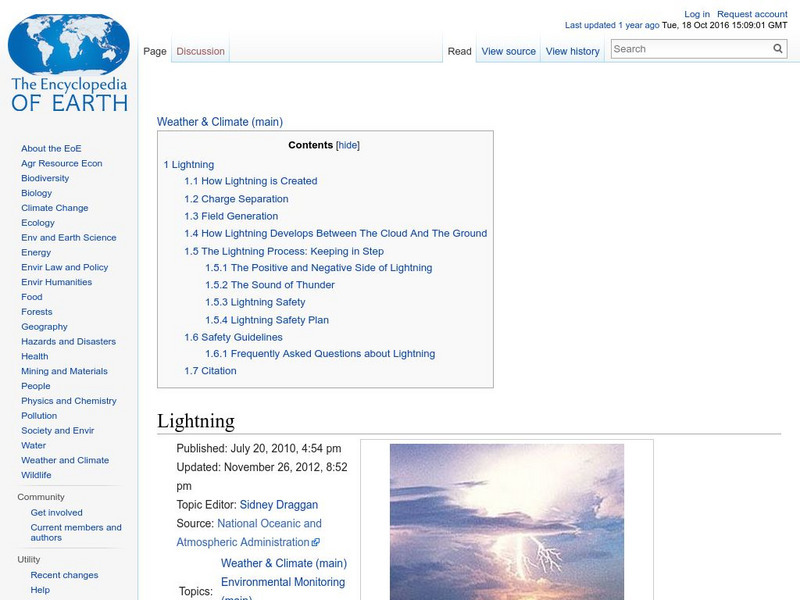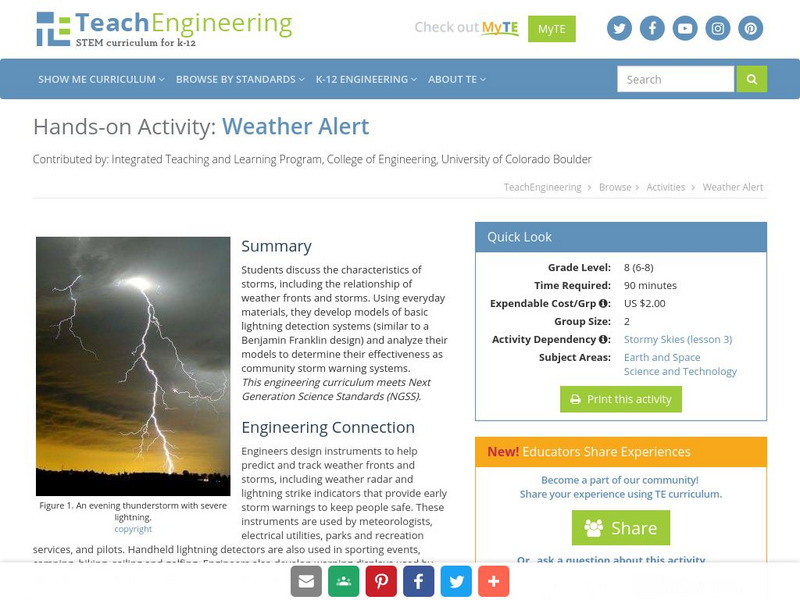Ready
Ready: Make a Plan
Thorough resource that covers preparing for natural and man-made disasters and hazards.
Encyclopedia of Earth
Encyclopedia of Earth: Weather & Climate: Lightning
Explains what lightning is, how it is created, what happens inside thunderstorms, how lightning develops during a storm, types of lightning, how individuals and groups can stay safe, chances of being struck by lightning, and answers to...
TED Talks
Ted: Ted Ed: The Most Lightning Struck Place on Earth
Lake Maracaibo is the stormiest place on the planet. Thunderstorms rage above this massive body of water for up to 200 days of the year, with each ear-splitting event lasting for several hours. Graeme Anderson lists the factors that...
TED Talks
Ted: Ted Ed: How Do Tornadoes Form?
Meteorologist James Spann sheds light on the lifespan of tornadoes as they go from supercell thunderstorms to terrible twisters before eventually dissolving back into thin air. [4:11]
TeachEngineering
Teach Engineering: Naturally Disastrous
Students are introduced to natural disasters, and learn the difference between natural hazards and natural disasters. They discover the many types of natural hazards - avalanche, earthquake, flood, forest fire, hurricane, landslide,...
Other
Steve Spangler Science: Denver's Brown Cloud
Learn how fluids move through our atmosphere and water. This experiment explains atmospheric convection currents (thunderstorms), the Gulf Stream, and temperature inversion. A video is included.
NOAA
Noaa: Environmental Technology Lab: Infrasonics Program
This resource focuses on research of infrasonic sounds found in the environment. It discusses such infrasonic sources as volcanoes, avalanches, severe thunderstorms, and earthquakes.
University Corporation for Atmospheric Research
Ucar: Weather Fronts
When a front passes over an area, it means a change in the weather. Many fronts cause weather events such as rain, thunderstorms, gusty winds and tornadoes.
USA Today
Usa Today: Understanding Clouds and Fog
Learn about the different kinds of clouds, their location in the sky, how they form, their influence on the weather, and unusual cloud shapes.
Other
American Red Cross: Masters of Disaster: Grades 6 8
This resource presents many science lessons with related activities for students in grades 6-8. Content addresses tools for coping with disasters such as tornadoes, fires, lightning, floods and general preparedness.
NOAA
Noaa: National Weather Service: Jet Stream: Jet Stream Learning Lessons
Here's a comprehensive list of lesson plans offered by the National Weather Service covering the gamut of weather topics from the atmosphere to synoptic meterology. The plans include objectives, supplies necessary for the lesson, teacher...
NASA
Nasa: Spirits of Another Sort
What is a sprite? Read this article to learn more and even discover how to find one. (June 10, 1999)
TeachEngineering
Teach Engineering: Weather Alert
Students discuss the characteristics of storms, including the relationship of weather fronts and storms. Using simple materials, the students develop a model of a simple lightning detection system and analyze their model to determine its...
National Weather Service
National Weather Service: Basic Weather Spotters' Field Guide [Pdf]
Written in an Adobe PDF file, this publication teaches about basic weather phenomena and how to recognize advancing severe weather systems in real time.
NOAA
Noaa: Owlie Skywarns Weather Book [Pdf]
Download and print this free activity book about hurricanes, tornadoes, lightening, floods and winter storms. A quiz section is also included.
The Field Museum
Field Museum: Exhibits: Nature Unleashed: Inside Natural Disasters
Discover the true powers of Mother Nature through this vivid collection of research which delves into the causes of natural disasters and the impacts on those affected.
Dan Satterfield
Dan's Wild Weather Page: Precipitation
Find out about what causes precipitation and perform activities that teaches how precipitation forms.
University Corporation for Atmospheric Research
Ucar: Fact Sheet: Hail
How is hail formed? What happens as a hailstone falls through the air? Find the answers to these questions, and see a photo of crops damaged by hail.
American Geosciences Institute
American Geosciences Institute: Earth Science Week: Lightning
This activity will demonstrate the attraction of positive and negative charges and what happens when those opposite charges meet each other.
University of Wisconsin
The Why Files: Light on Lightning! Danger!
Experience the acoustical shadow caused by a lightning bolt, and discover the dangers of a lightning storm.
Read Works
Read Works: Wild Weather
[Free Registration/Login Required] Students read about different types of March weather including: clouds, blizzards, thunder, lightning, and rainbows. A question sheet is available to help students build skills in cause and effect.
University of Wisconsin
The Why Files: Twister: The Tornado Story
The Why? Files, provided by the University of Wisconsin provides a discussion of tornadoes and the environmental conditions that generate them. Includes some great pictures of the formations of the whirlwinds. Also includes a link to a...
NASA
Nasa Earth Observatory: The Color of El Nino
This article explains the effects El Nino has had on different climates and natural disasters throughout the world.
Other popular searches
- Thunderstorms Clapping
- Severe Thunderstorms
- Videos on Thunderstorms
- Thunderstorms and Rain
- Thunderstorms Model
- Thunderstorms and Lightening
- Summer Thunderstorms
- Viedos on Thunderstorms
- Thunderstorms 4th
- Earth Science Thunderstorms
- Webquest on Thunderstorms
- Thunderstorms Worksheets




















